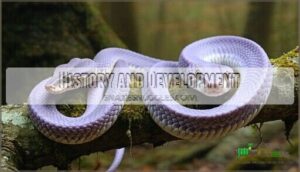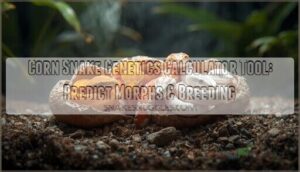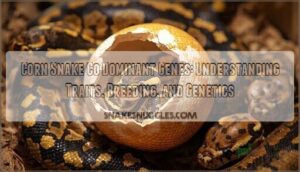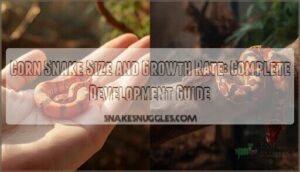This site is supported by our readers. We may earn a commission, at no cost to you, if you purchase through links.

The lavender variety gets its unique color from a mix of amelanistic and diffused genes, making it a favorite for reptile collectors.
Native to the southeastern United States, corn snakes thrive in forests, fields, and even abandoned barns, where they help control rodent populations.
Known for their calm nature, these snakes are easy to handle and care for, making them perfect for beginners, and if you are curious about their diet or habitat setup, stick around for helpful tips!
Table Of Contents
- Key Takeaways
- What is a Lavender Corn Snake?
- History and Development
- Misidentification and Similar Morphs
- Frequently Asked Questions (FAQs)
- Are lavender corn snakes real?
- How to care for a lavender corn snake?
- What is the rarest corn snake morph?
- How long do lavender corn snakes live?
- What is the most unique corn snake?
- What do lavender corn snakes eat?
- What colors can corn snakes be?
- How long do lavender corn snakes typically live?
- What size enclosure does a lavender corn snake need?
- How often should you feed a lavender corn snake?
- Conclusion
Key Takeaways
- You’ll love their soft lavender-gray bodies with peach hues and glowing ruby-red eyes, making them a pastel masterpiece.
- Lavender corn snakes are easy to handle and thrive on frozen mice, perfect for beginners looking for a low-maintenance pet.
- These snakes live 15–20 years in captivity with the right care, including a 40-gallon tank, a temperature gradient of 75-85°F, and proper humidity levels.
- Breeders created this stunning morph through recessive genetics, making it a must-have for reptile enthusiasts.
What is a Lavender Corn Snake?
The Lavender Corn Snake, scientifically known as Pantherophis guttatus, is a stunning color morph created through a recessive genetic mutation.
A mesmerizing blend of soft lavender hues and frosted patterns, the Lavender Corn Snake is nature’s pastel masterpiece.
Its pale gray body, accented with soft pink or peach hues and frosted saddle patterns, gives it a unique lavender-like appearance despite lacking actual purple scales.
Genetic Basis
Ever wondered what gives the lavender corn snake its stunning hues? It’s all about recessive alleles! These genetic mutations reduce red pigmentation, creating that soft lavender appearance.
Here’s how it works:
- Recessive Inheritance: Both parents must carry the lavender gene.
- Selective Breeding: Breeders pair carriers to produce vibrant corn snake morphs.
- Morph Combinations: Mix lavender with genes like caramel for the rare Amaretto variant.
- Snake Genetics Research: Reveals endless possibilities in reptile genetics!
Breeders should also consider potential kinking tendencies in certain morphs.
Appearance
The lavender corn snake stands out with its unique snake coloration and graceful body shape. Its lavender color ranges from soft lavender-gray to subtle purples, often accented by faint pink or peach hues.
You’ll notice their scale patterns feature medium-gray saddles with lighter borders.
- Head Markings: A pale V-shape behind the eyes fades with age.
- Color Variations: Hatchlings display pale browns, while adults shift to uniform lavender-gray.
- Size Differences: Females grow larger, reaching up to five feet.
These snakes have various color morphs available. Their corn snake colors make them unforgettable!
History and Development
Back in 1985, Rich Zuchowski introduced the first Lavender Corn Snake, nicknamed "Mocha," through selective breeding of a snow morph and a wild-caught female.
In 1985, Rich Zuchowski unveiled "Mocha," the first Lavender Corn Snake, sparking a revolution in snake morph breeding.
This recessive mutation, now called the lavender gene, sparked curiosity and confusion among breeders. Early breeding efforts, led by John Albrecht, confirmed its genetic identity, solidifying its place as a unique morph.
The lavender gene results in stunning, pale coloration.
- Breeders in Pennsylvania and New Jersey popularized this morph.
- Its rise showcases the creativity behind morph origins and early breeding efforts.
Misidentification and Similar Morphs
When identifying a lavender corn snake, it’s easy to mix it up with other snake morphs due to subtle overlaps in color and pattern.
Here’s how to avoid confusion:
- Snow Corns: Their pale tones can mimic lavender hues.
- Anerythristic Morphs: These lack red pigment but may show faint lavender sheens.
- Amelanistic Morphs: Their light bodies and ruby eyes often resemble Lavenders.
- Hypo Morphs and Caramel Morphs: Both display muted tones, adding to misidentifications.
Genetic testing guarantees accurate classification of this stunning morph.
Frequently Asked Questions (FAQs)
Are lavender corn snakes real?
When it rains, it pours—yes, lavender corn snakes (Pantherophis guttatus) are real!
They’re stunning, non-venomous snakes with pale gray, peach, and lavender hues, native to the southeastern U.S.
They thrive in grassy or forested habitats.
How to care for a lavender corn snake?
To care for Pantherophis guttatus, provide a 40-gallon tank, 75–85°F temperature gradient, 65–75% humidity, aspen bedding, and hiding spots.
Feed frozen mice weekly, monitor shedding, and handle gently for a calm, friendly companion, ensuring a calm environment.
What is the rarest corn snake morph?
You might think rare means flashy, but the Palmetto corn snake (Pantherophis guttatus) takes the crown.
Its white body, speckled with random red, orange, and gray scales, creates a stunning, one-of-a-kind appearance.
How long do lavender corn snakes live?
Lavender corn snakes (Pantherophis guttatus) live 15 to 20 years in captivity with proper care.
Their lifespan depends on maintaining ideal humidity, temperature, and diet—think of it as their version of a spa retreat!
What is the most unique corn snake?
The Palmetto corn snake stands out as the most unique.
Its white body, speckled with random red, orange, and gray scales, creates a stunning “confetti” effect.
It’s like a living piece of abstract art!
What do lavender corn snakes eat?
Ever wonder what Pantherophis guttatus craves?
These snakes thrive on pre-killed, frozen mice—no fruits, bugs, or extras needed.
Their meat-only diet simplifies care, ensuring nutrition while avoiding parasites.
Feed weekly, and they’ll stay content!
What colors can corn snakes be?
Corn snakes (Pantherophis guttatus) display a rainbow of colors, from vibrant reds, oranges, and yellows to subtle grays, whites, and pinks.
Their patterns vary too, with morphs like albino, anerythristic, and snow showcasing unique combinations.
How long do lavender corn snakes typically live?
These snakes usually live around 15 to 20 years in captivity with proper care.
Keeping their habitat warm, humid, and safe helps guarantee they thrive, giving you years of enjoyment with this gentle, colorful companion.
What size enclosure does a lavender corn snake need?
A lavender corn snake thrives in a 20-gallon tank, though a 40-gallon enclosure is ideal.
Make certain proper ventilation, hiding spots, and a temperature gradient between 75-85°F, providing space to slither and feel secure.
How often should you feed a lavender corn snake?
Feed adult Pantherophis guttatus once a week with pre-killed, frozen mice, while hatchlings eat every 5–7 days.
Avoid handling for 48 hours after meals to prevent regurgitation and make certain their digestion runs smoothly.
Conclusion
Caring for a lavender corn snake is as easy as pie with a little preparation and enthusiasm.
These mesmerizing creatures, with their soft lavender tones and glowing ruby eyes, blend beauty with a laid-back personality, making them ideal pets.
By recreating their southeastern U.S. habitat—think cozy hides, the right heat levels, and a healthy rodent diet—you’ll make certain a happy, thriving Pantherophis guttatus.
Jump in confidently, and let this stunning snake add a dash of wonder to your home, with its ability to bring a unique element of beauty and enchantment!







